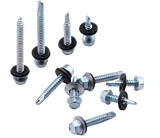These screws are commonly used in construction, metalworking, and various industrial applications to secure materials such as metal, wood, or plastic.
-
Composition:
- Material: Typically made from hardened steel, stainless steel, or coated materials to provide strength and corrosion resistance.
- Coatings: Often coated with zinc, nickel, or other protective layers to enhance durability and resist rust, particularly in outdoor or corrosive environments.
-
Design Features:
- Drill Tip: The key feature of self-drilling screws is the tip, which functions as a drill bit. This allows the screw to both drill a hole and fasten the materials in one step.
- Threading: Self-drilling screws have sharp, deep threads designed to cut through materials like metal or wood as they are driven in. The threading helps in securely fastening the materials together.
- Head Types: Common head designs include hex, pan, and flat heads. Hex heads are often used with metal roofing, while flat heads are ideal for surfaces that need to be flush.
- Drive Types: These screws come with various drive types such as Phillips, square, or hex drives, depending on the application and tool used.
-
Types:
- Tek Screws: These are commonly used in metal-to-metal or metal-to-wood applications, featuring a drill point for quick penetration.
- Roofing Screws: Typically used in metal roofing, these screws come with a sealing washer to prevent water from entering.
- Wing-Tipped Screws: Designed to drill through thicker materials, such as wood-to-metal fastening, with wings that break off as the screw tightens.
-
Applications:
- Metalworking: Commonly used in joining metal sheets, such as in roofing or siding applications.
- Construction: Used in wood or metal framing, as well as securing panels or other construction materials.
- HVAC Systems: Ideal for fastening ductwork and other components without the need for pre-drilling.
- Automotive: Used in assembling vehicle parts where metal-to-metal connections are necessary.
-
Advantages:
- No Pre-Drilling Required: The built-in drill tip eliminates the need for a separate drilling step, saving time and effort during installation.
- Fast and Efficient: Self-drilling screws speed up construction and assembly processes, especially in industrial applications.
- Strong Holding Power: Designed for secure fastening, especially in metal or metal-to-wood applications.
- Versatility: Available in various lengths, diameters, and head types for different materials and uses.
-
Challenges:
- Material Limitations: While effective in thin materials like sheet metal, self-drilling screws may struggle in very thick or hard metals without proper selection.
- Stripping Risk: Over-tightening or using the wrong drive bit can strip the screw head or threads.




![Sanding Sheets Abrasives [MSMEs]](/content/images/thumbnails/1078_160_sanding-sheets-abrasives-msmes-_.png)
![Flap Discs Abrasives [MSMEs]](/content/images/thumbnails/1080_160_flap-discs-abrasives-msmes-_.png)
![Sanding Belts Abrasives [MSMEs]](/content/images/thumbnails/1081_160_sanding-belts-abrasives-msmes-_.png)
0 Comment
Leave a Comment